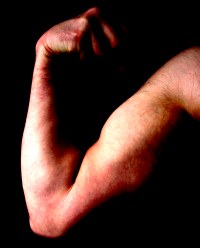Mechanism of Muscle Contraction
Muscle Puzzle
by David Bradley
 Professor Hugh Huxley FRS, of Brandeis University in Waltham, Massachusetts,
was one of the pioneers of the research that laid bare the mechanism of
muscle contraction in the 1950s. While on leave at MIT from Cambridge's
Cavendish Laboratory he collaborated with the late Jean Hanson also on leave
there from King's College London. Huxley used microscopy to examine changes
in the diffraction patterns of fresh frog muscle fibre at various stages of
relaxation and contraction.
Professor Hugh Huxley FRS, of Brandeis University in Waltham, Massachusetts,
was one of the pioneers of the research that laid bare the mechanism of
muscle contraction in the 1950s. While on leave at MIT from Cambridge's
Cavendish Laboratory he collaborated with the late Jean Hanson also on leave
there from King's College London. Huxley used microscopy to examine changes
in the diffraction patterns of fresh frog muscle fibre at various stages of
relaxation and contraction.
Huxley reasoned that rather than the filaments themselves contracting, the
fibres contracted from fixed points of cross-connection. The result was the
"sliding filament model" of muscle contraction. In this model, the thick
filaments of the motor protein myosin slide along the thin filaments, the
actin chains, using ATP as their energy source. It is this interaction of
two separate proteins that results in the development of tension or
contraction of the muscle. Hanson and Huxley published their new model in
the journal Nature in 1954, back to back with results from the independent
team of Cambridge's Andrew Huxley (no relation) and Ralph Niedergerke.
Today, Huxley, and other researchers, are still puzzling over the details of
this model. In particular, they are trying to elucidate, with molecular
detail, the dynamics of the changes taking place in the crossbridges between
the myosin and the actin filaments during muscle contraction. A cyclic
interaction between the myosin crossbridges and sites on the actin filaments
has been implicated in this interaction, but until recent technical advances
studies have been unable to probe this process deeply.
Huxley explained how powerful X-ray sources are allowing his team to obtain
sub-microscopic structural information about the cross-bridges and their
cyclic operation and about the on-off switching of muscle. The
high-resolution achievable with these X-ray sources means fine detail in the
heads of the myosin molecules, which are crucial to the cross-bridges, can
be observed during the power stroke of the muscle. Such detail is providing
researchers with a clear understanding of how tension develops in a
contracting muscle.
Part 3 -
Do the
twist
 Professor Hugh Huxley FRS, of Brandeis University in Waltham, Massachusetts,
was one of the pioneers of the research that laid bare the mechanism of
muscle contraction in the 1950s. While on leave at MIT from Cambridge's
Cavendish Laboratory he collaborated with the late Jean Hanson also on leave
there from King's College London. Huxley used microscopy to examine changes
in the diffraction patterns of fresh frog muscle fibre at various stages of
relaxation and contraction.
Professor Hugh Huxley FRS, of Brandeis University in Waltham, Massachusetts,
was one of the pioneers of the research that laid bare the mechanism of
muscle contraction in the 1950s. While on leave at MIT from Cambridge's
Cavendish Laboratory he collaborated with the late Jean Hanson also on leave
there from King's College London. Huxley used microscopy to examine changes
in the diffraction patterns of fresh frog muscle fibre at various stages of
relaxation and contraction.